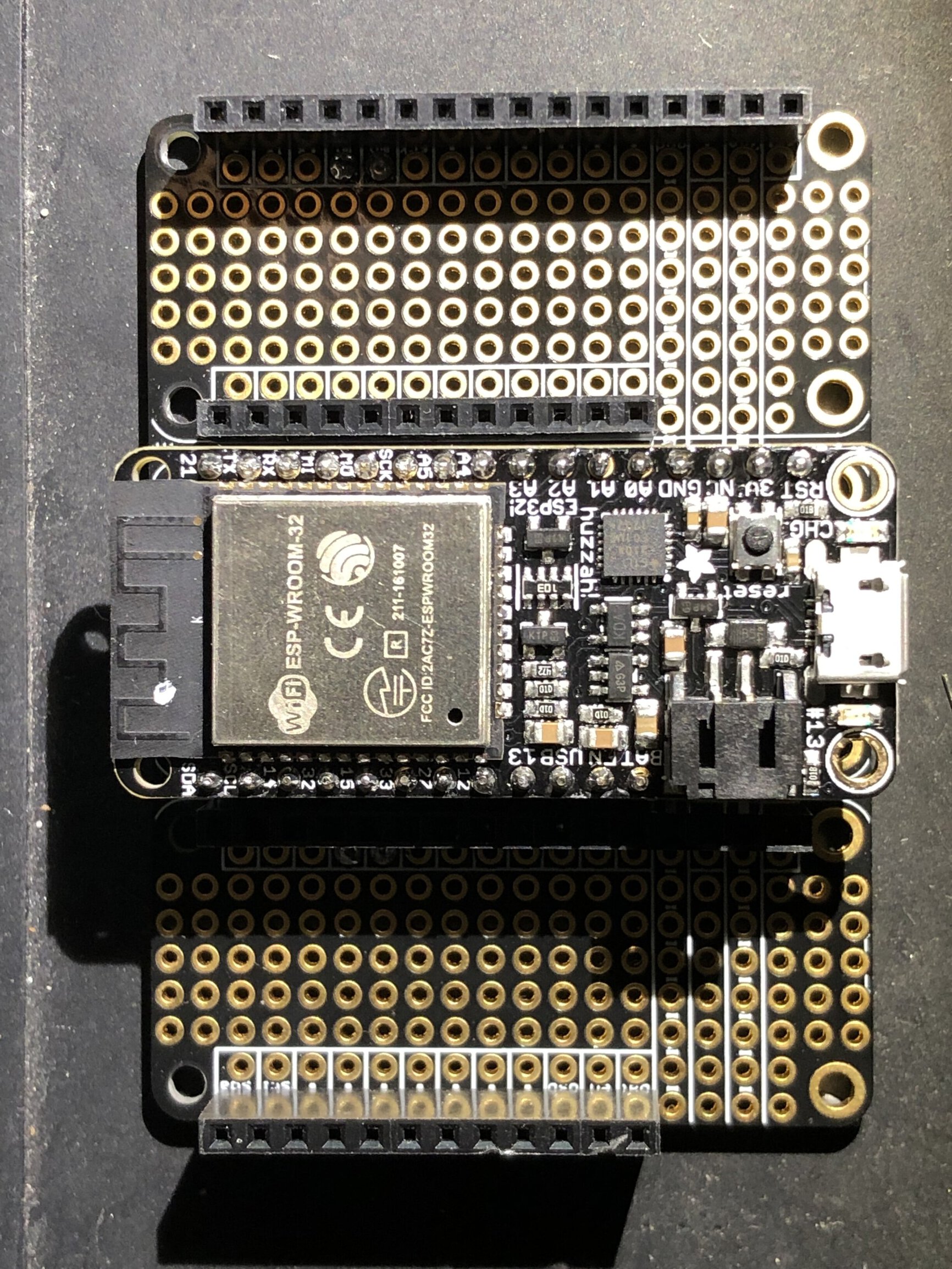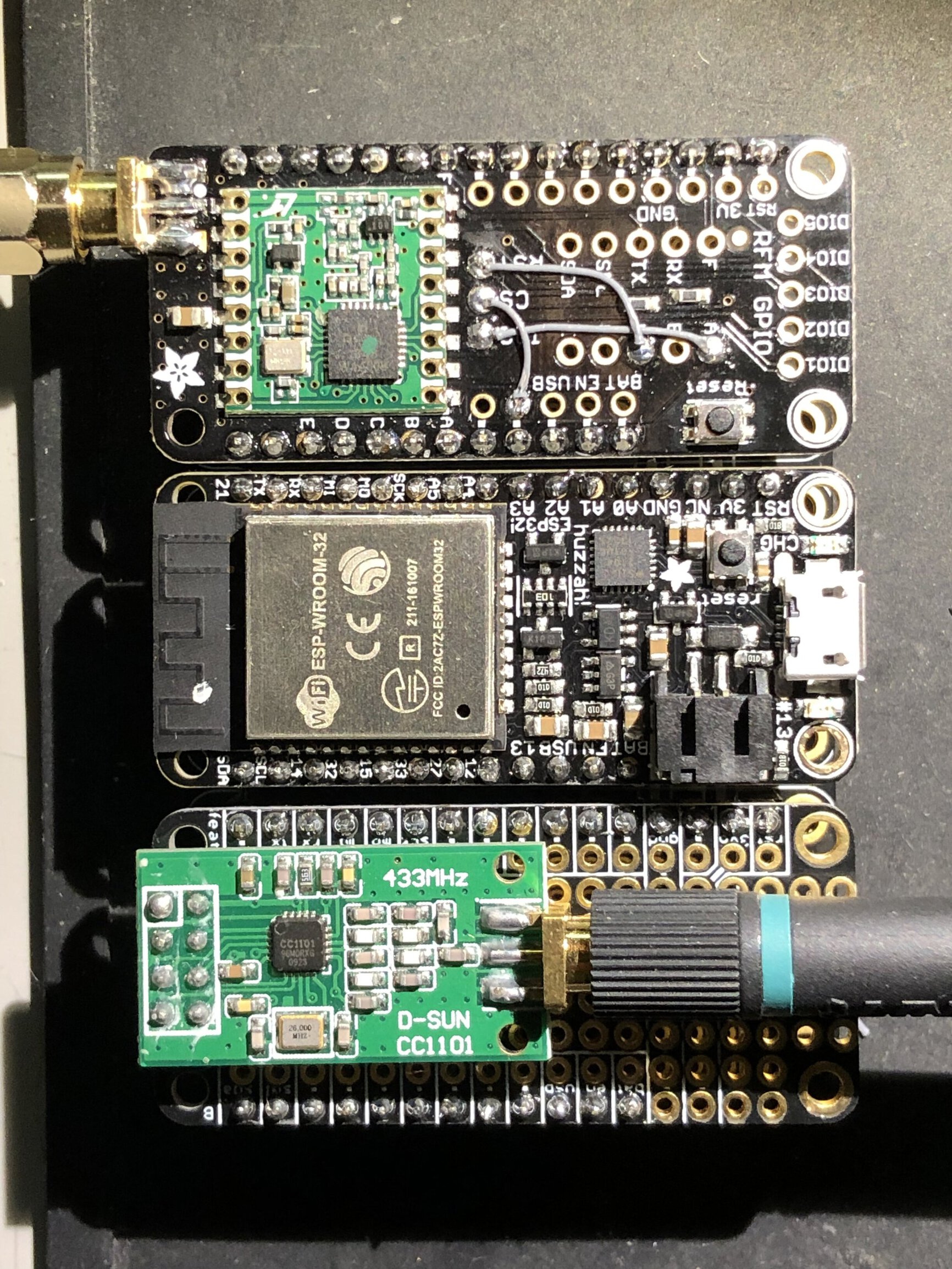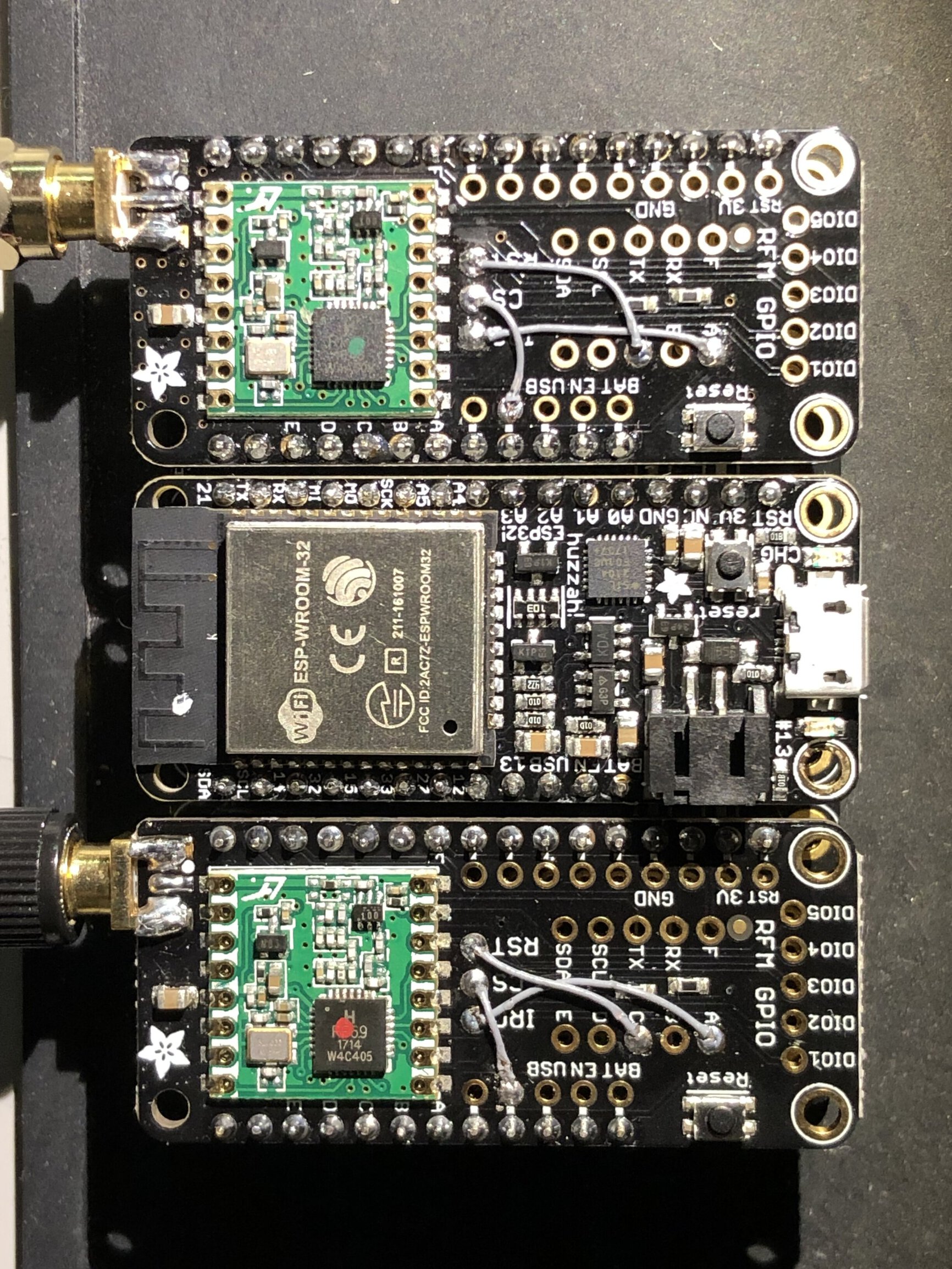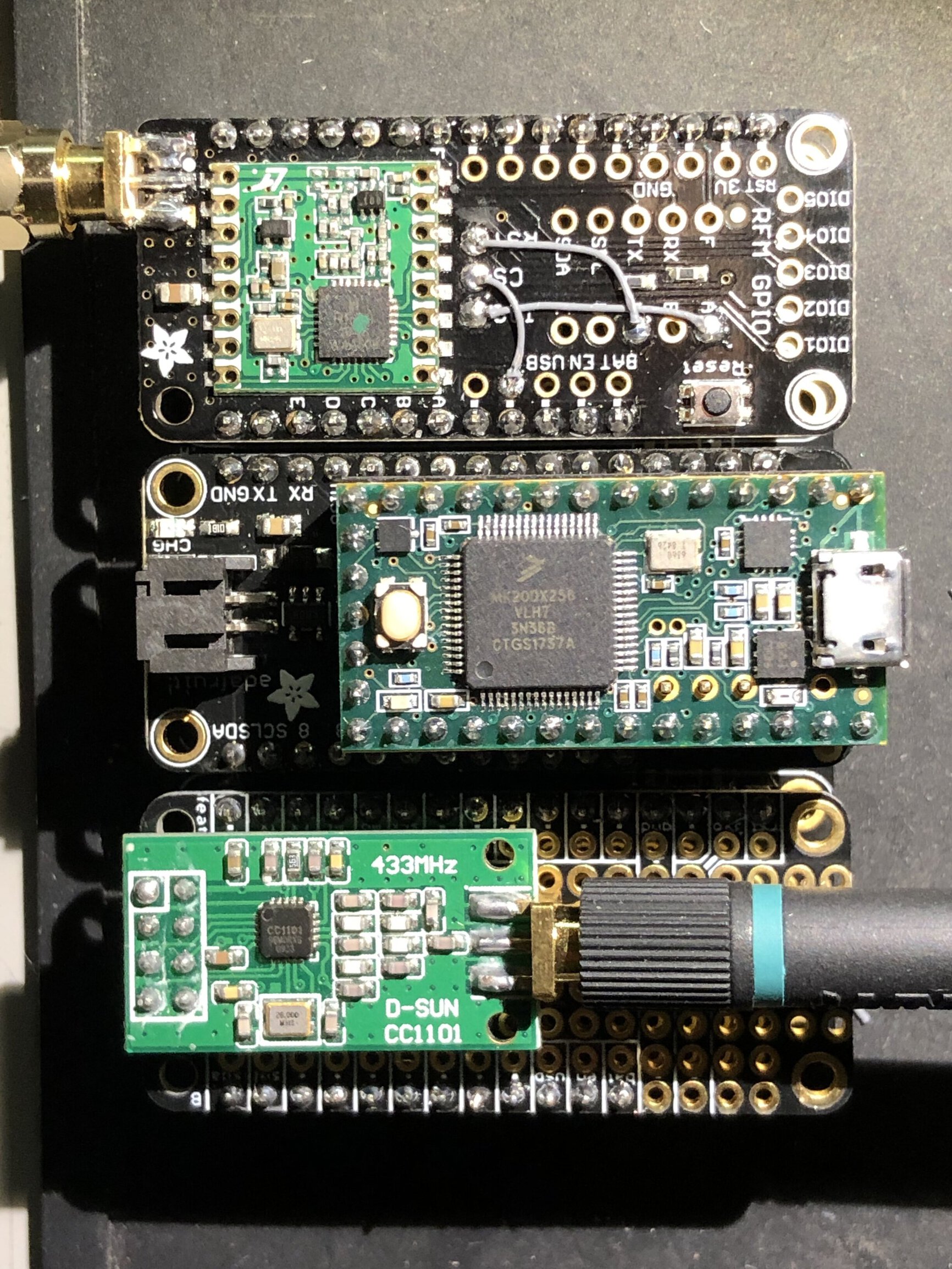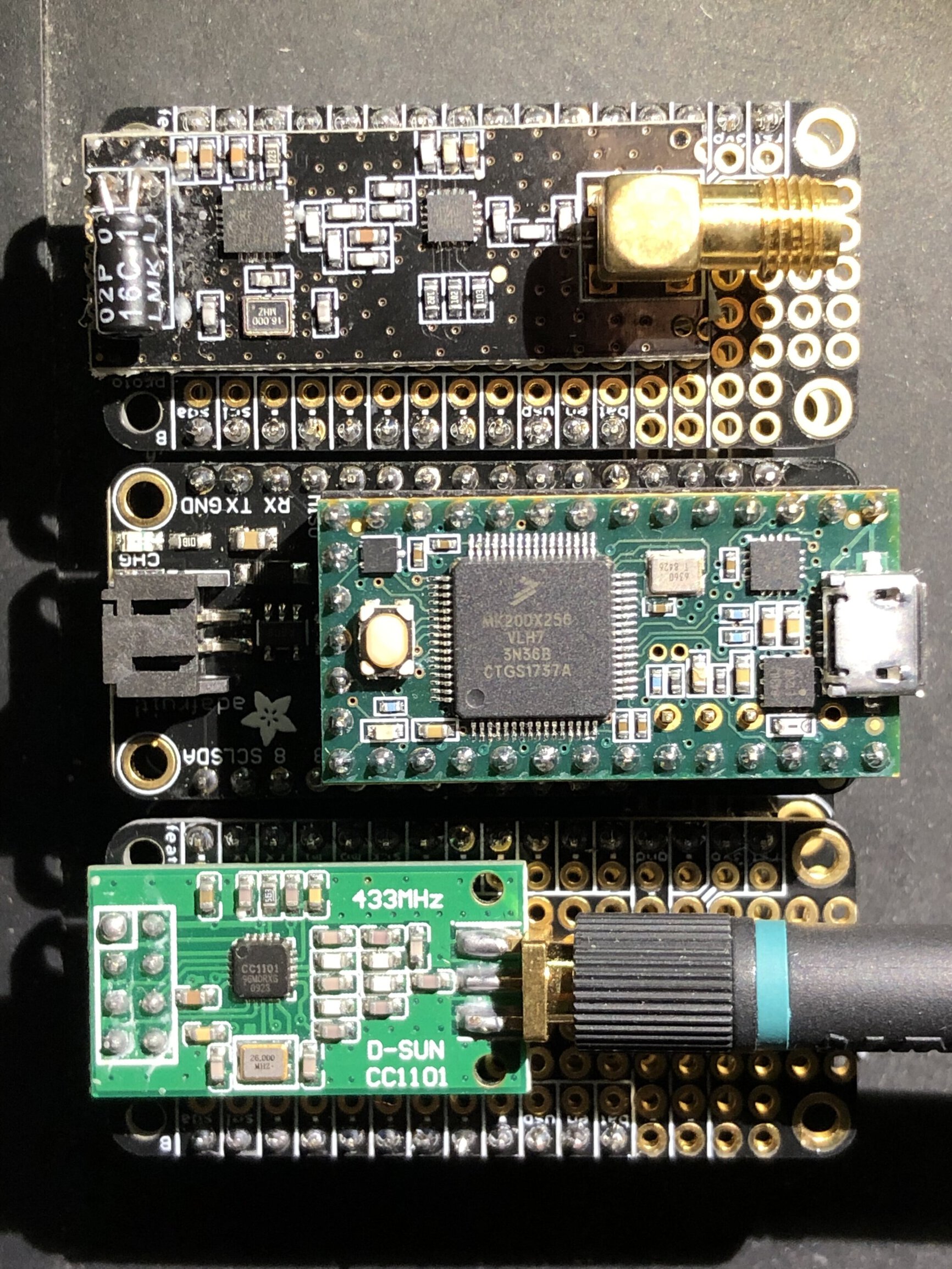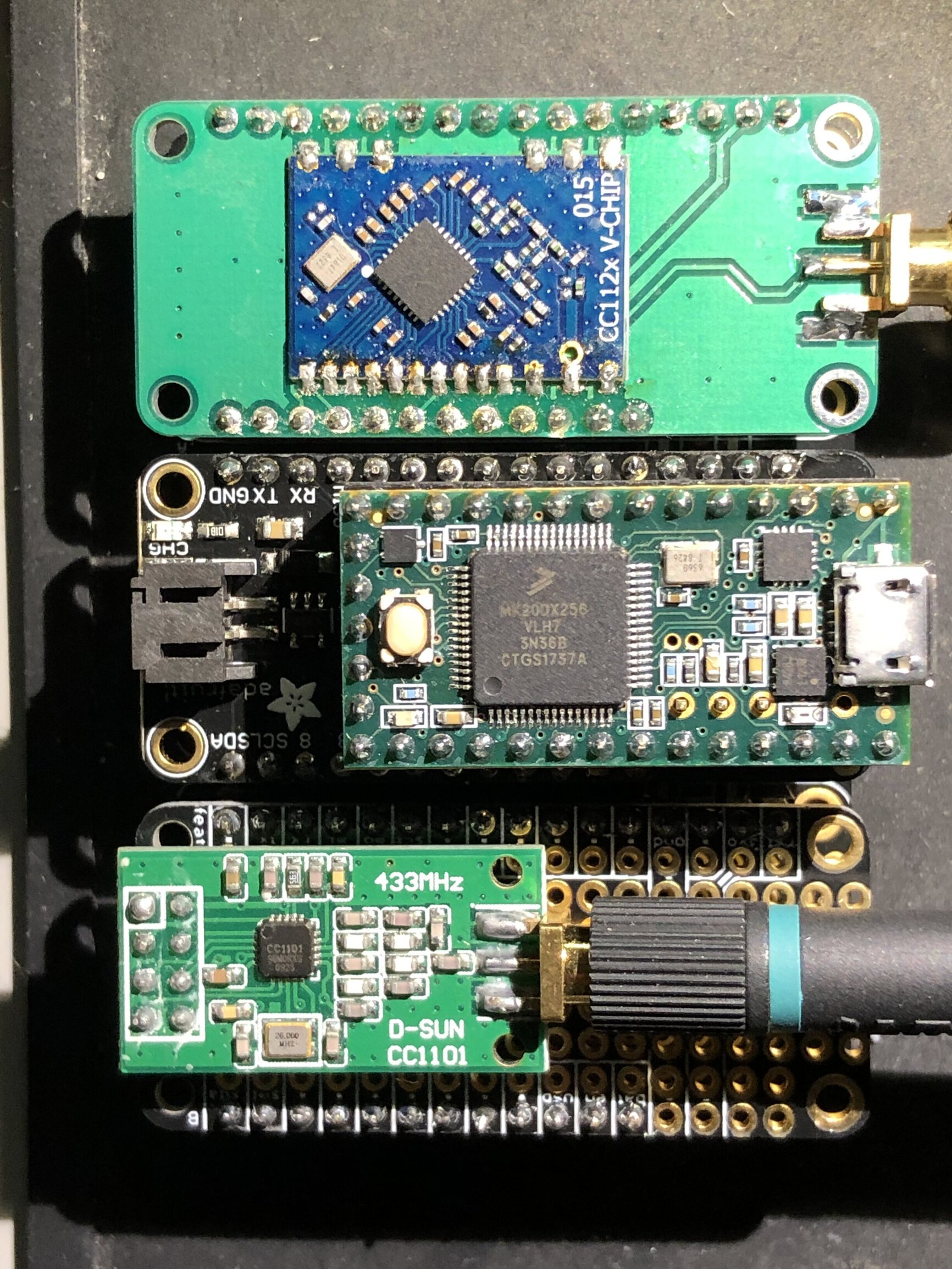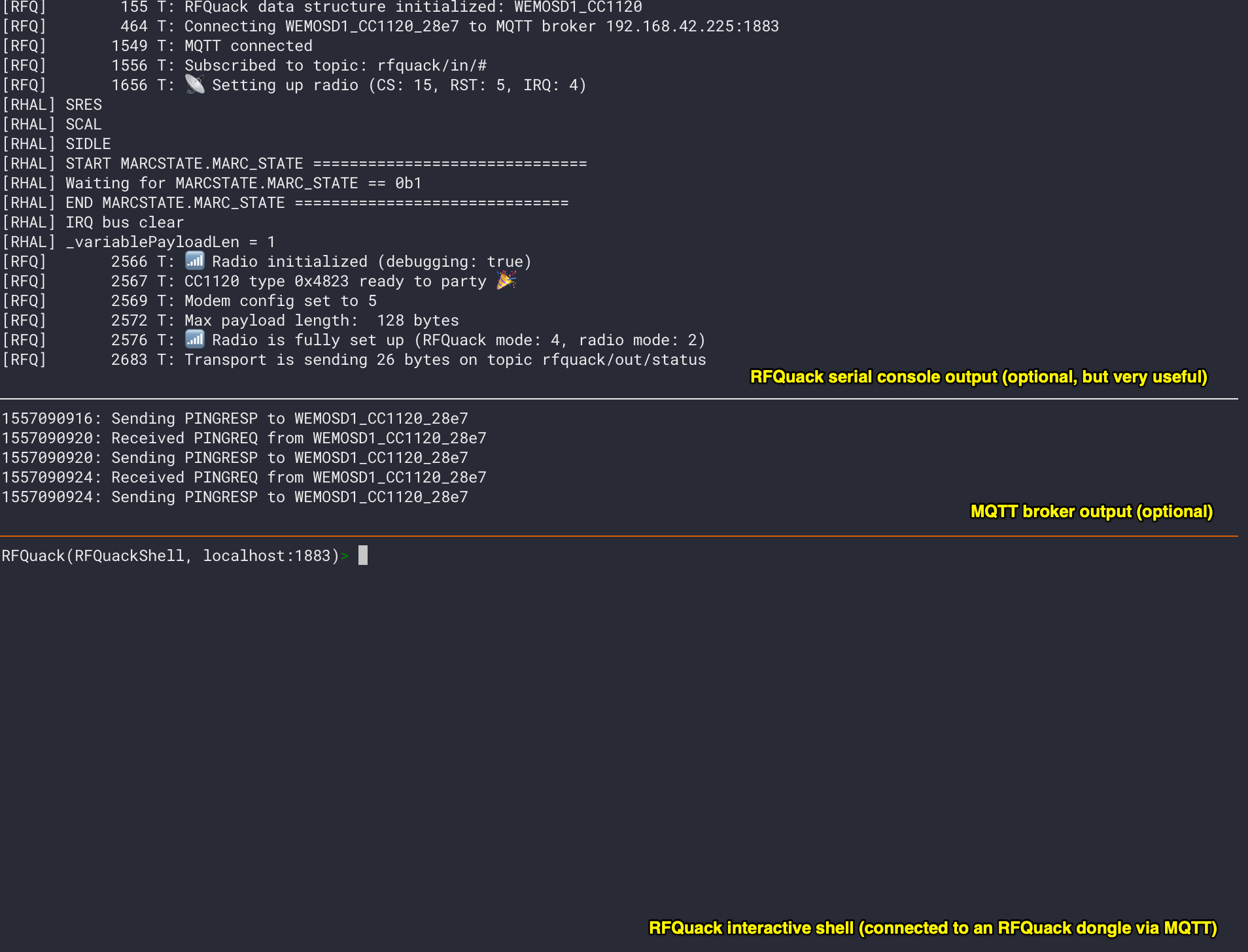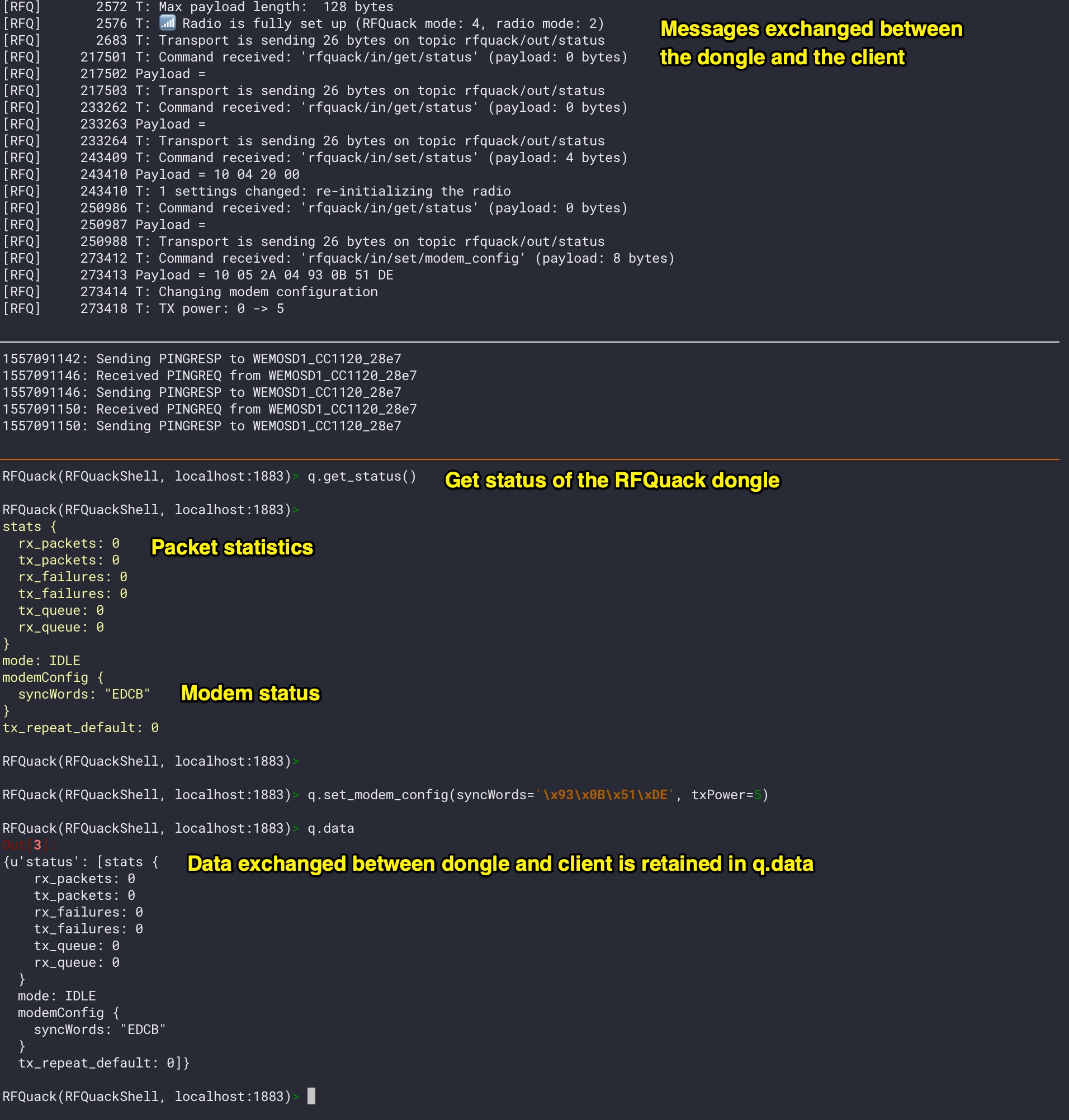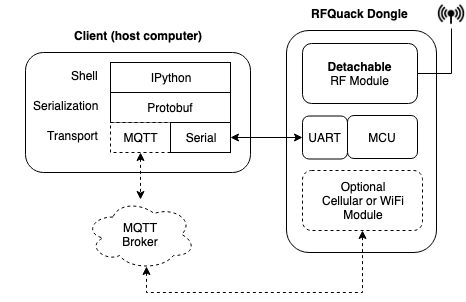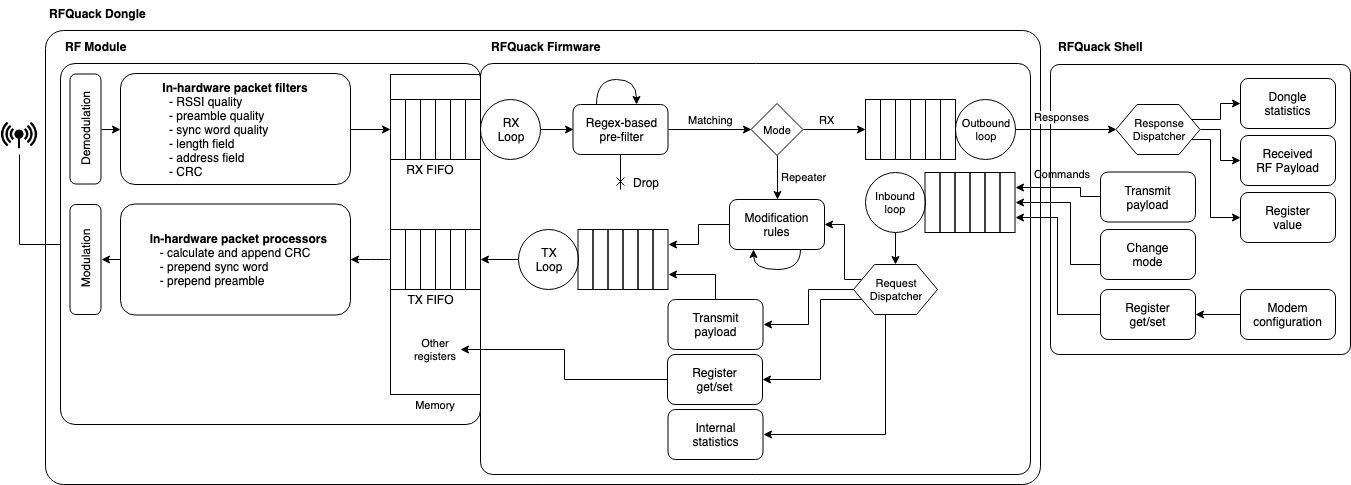RFQuack is the only versatile RF-analysis tool that quacks!
It's a library firmware that allows you to sniff, manipulate, and transmit data over the air. And if you're not happy how the default firmware functionalities or you want to change the hardware, we made it easy to extend. Consider it as the hardware-agnostic and developer-friendly version of the great YardStick One, which is based on the CC1101 radio chip. Differently from the other RF dongles, RFQuack is designed to be agnostic with respect to the radio chip. So if you want to use, say, the RF69, you can do it. If you need to use the CC1101L or CC1120, you can do it. Similarly to RFCat, RFQuack has a console-based, Python-scriptable client that allows you to set parameters, receive, transmit, and so on.
We assume you know what you're doing 🤓
- RFQuack
- Discord: https://discord.gg/6c8hcGbdc5
- Twitter: https://twitter.com/rfquack
Not really. RFQuack is midway between software-defined radios (SDRs), which offer great flexibility at the price of a fatter code base, and RF dongles, which offer great speed and a plug-and-play experience at the price of less flexibility p(you can't change the radio module).
RFQuack is unique in these ways:
- It's a library firmware, with many settings, sane defaults, and rich logging and debugging functionalities.
- Supports multiple radio chips: nRF24, CC1101, basically all the chips supported by RadioLib, and we're adding more.
- Does not require a wired connection to the host computer: the serial port is used only to display debugging messages, but the interaction between the client and the node is over TCP using WiFi (via Arduino WiFi) and GPRS (via TinyGSM library) as physical layers.
- The RFQuack client allows both high- and low-level operations: change frequency, change modulation, etc., as well as to interact with the radio chip via registers.
- The firmware and its API support the concept of packet-filtering and packet-modification rules, which means that you can instruct the firmware to listen for a packet matching a given signature (in addition to the usual sync-word- and address-based filtering, which normally happen in the radio hardware), optionally modify it right away, and re-transmit it.
So, if you need to analyze a weird RF protocol with that special packet format or that very special modulation scheme, with mixed symbol encodings (yes, I'm looking at you, CC1120 in 4-FSK mode 🤬), with RFQuack you just swap the radio shield and you can just start working right away. And if we don't support that special radio chip, you can just craft your shield and add support to the software!
RFQuack is quite experimental, expect glitches and imperfections. So far we're quite happy with it, and used it successfully to analyze some industrial radio protocols (read the Trend Micro Research white paper or the DIMVA 2019 paper for details).
- Choose the radio chip and board that you want to use among the supported ones: we tested the CC1101, nRF24 and ESP32-based boards (namely the Adafruit Feather HUZZAH32).
- Assemble the board and the radio chip together: if you choose the Adafruit Feather system, all you have to do is stack the boards together, and do some minor soldering.
- Connect the board to the USB port.
| Main board | Radio daughter board | Network connectivity | Cellular connectivity |
|---|---|---|---|
| Feather HUZZAH32 | Feather nRF24 | ESPWiFi | Not tested |
| Feather HUZZAH32 | Feather CC1101 | ESPWiFi | Not tested |
| Feather FONA | Radio FeatherWing RFM69HW 433 MHz | None | Tested with early versions of RFQuack |
You could play around with other combinations, of course. And if you feel generous, you can fork this repository, add support for untested hardware, and send us a pull request (including schematics for new daughter-boards)! 👏
The quickest way to get started is by mean of our Docker image. It will automatically build and upload the code to any supported board.
- Make sure you have Docker installed.
- Run the Docker container: it'll upload RFQuack to any connected board. Use the cheat sheet and look for your configuration:
We provilde a helper Makefile and a build.env to set the variables.
make docker-build # or make docker-build-nc to force re-building
make buildPORT=/dev/ttyUSB0 make flashThis is what the helper Makefile is doing.
| Command | Description |
|---|---|
docker run -e BOARD=HUZZAH32 -e RADIOA=CC1101 -e RADIOA_CS=2 -e RADIOA_IRQ=5 --rm -it rfquack/rfquack |
Build an RFQuack image for an Adafruit HUZZAH32 target, with a CC1101 (Chip Select on PIN2, GDO0 on PIN5) |
docker run --device=/dev/ttyUSB0:/board -e BOARD=HUZZAH32 -e RADIOA=CC1101 -e RADIOA_CS=2 -e RADIOA_IRQ=5 --rm -it rfquack/rfquack |
Build and upload RFQuack to an Adafruit HUZZAH32 target (on /dev/ttyUSB0), with a CC1101 (Chip Select on PIN2, GDO0 on PIN5) |
docker run --device=/dev/ttyUSB0:/board -e BOARD=HUZZAH32 -e RADIOA=nRF24 -e RADIOA_CS=5 -e RADIOA_IRQ=4 -e RADIOA_CE=2 --rm -it rfquack/rfquack |
Build and upload RFQuack for an Adafruit HUZZAH32 target (on /dev/ttyUSB0), with a nRF24 (Chip Select on PIN5, IRQ on PIN4, Chip Enable on PIN2) |
Please, change the CS, IRQ and CE pins according to your wiring. (More about container's variables)
- Done 😎 RFQuack is installed on your hardware and reachable via serial. It's time to test it!
RFQuack comes in the form of a firmware library, which means that you need to write your own "main" to define a minimum set of parameters. Don't worry, there's not much to write in there, and we provide a few working examples.
-
Clone this repository
-
Make sure you have
platformioandprotocinstalled. -
Install
Nanopb 0.3.9.2usingplatformio lib -g install git+https://github.com/nanopb/nanopb.git#0.3.9.2 -
Enter the main directory:
cd RFQuack -
Generate protobuf implementations:
make proto -
Install the RFQuack library via
platformio lib -g install file://./(if you want to install it globally)NOTE Platformio will copy the library to its internal storage. Any change to sources will not be reflected.
-
To talk to your RFQuack dongle, you have two options:
- MQTT Transport (and hardware serial console): install or have access to an MQTT broker (Mosquitto is just perfect for this):
- PROs:
- you don't need cables (hint: your RFQuack hardware can be battery powered)
- if you want to connect the RFQuack hardware to your computer, you get a free (hardware) serial console for monitoring on the USB port
- CONs:
- you need network connectivity (WiFi or cellular)
- there's latency
- PROs:
- Hardware Serial Transport (and software serial console): connect the dongle via USB
- PROs:
- there's little latency
- you don't need to rely on network stability
- CONs:
- if you want full monitoring and debugging capabilities, you'll need to hookup a UART cable to the RFQuack hardware (by default, a software serial device is used, and will write on pins 16, 12 (RX, TX); this can be changed by defining
RFQUACK_LOG_SS_RX_PINandRFQUACK_LOG_SS_TX_PINbefore#include <rfquack.h>) - your range is limited by the length of your USB cable (you don't say! 😮)
- if you want full monitoring and debugging capabilities, you'll need to hookup a UART cable to the RFQuack hardware (by default, a software serial device is used, and will write on pins 16, 12 (RX, TX); this can be changed by defining
- PROs:
- MQTT Transport (and hardware serial console): install or have access to an MQTT broker (Mosquitto is just perfect for this):
-
configure the firmware: best if you use one of the proposed examples.
Now you can use RFQuack via the IPython shell. We highly recommend tmux to keep an eye on the output log.
You need to install the RFQuack CLI package. For the sake of simplicity we'll run it through Docker:
$ docker run --rm -it rfquack/cli --help
Usage: rfquack [OPTIONS] COMMAND [ARGS]...
Options:
-l, --loglevel [CRITICAL|ERROR|WARNING|INFO|DEBUG|NOTSET]
-h, --help Show this message and exit.
Commands:
mqtt RFQuack client with MQTT transport.
tty RFQuack client with serial transport.$ docker run --rm -it rfquack/cli mqtt --help
Usage: rfquack mqtt [OPTIONS]
RFQuack client with MQTT transport. Assumes one dongle per MQTT broker.
Options:
-i, --client_id TEXT
-H, --host TEXT
-P, --port INTEGER
-u, --username TEXT
-p, --password TEXT
-h, --help Show this message and exit.$ docker run --rm -it rfquack/cli tty --help
Usage: rfquack tty [OPTIONS]
RFQuack client with serial transport.
Options:
-b, --baudrate INTEGER
-s, --bytesize INTEGER
-p, --parity [M|S|E|O|N]
-S, --stopbits [1|1.5|2]
-t, --timeout INTEGER
-P, --port TEXT [required]
--help Show this message and exit.More concretely:
$ docker run --device /dev/ttyUSB0 --rm -it rfquack/cli tty -P /dev/ttyUSB0
2019-04-10 18:04:31 local RFQuack[20877] INFO Transport initialized
2019-04-10 18:04:31 local RFQuack[20877] INFO Transport e initialized (QoS = 2): mid = 2
...
RFQuack(/dev/ttyUSB0, 115200,8,N,1)> q.radioA.set_modem_config(modulation="OOK", carrierFreq=434.437)
result = 0
message = 2 changes applied and 0 failed.
RFQuack(/dev/ttyUSB0, 115200,8,N,1)> q.radioA.rx()
result = 0
message =
...
At this point you're good to go from here!
RFQuack has a modular software and hardware architecture comprising:
- a radio chip (usually within a module)
- a micro-controller unit (MCU)
- an optional network adapter (cellular or WiFi)
The communication layers are organized as follows:
- The Python client encodes the message for RFQuack with Protobuf (via nanopb): this ensures data-type consistency across firmware (written in C) and client (written in Python), light data validation, and consistent development experience.
- The serialized messages are transported over MQTT (which allows multi-node and multi-client scenarios) or serial (when you need minimal latency).
- The connectivity layer is just a thin abstraction over various cellular modems and the Arduino/ESP WiFi (or simply serial).
- The message is decoded and handled by a software module
RFQuack's functionalities are built as pluggable modules, developed on top of a generic API.
When you fire up the Python shell, you can interact with the connected dongle through the q object; try auto-completion (tab is your friend) and discover each loaded module.
Each module has a built-in, super handy, helper function:
RFQuack(/dev/ttyUSB0, 115200,8,N,1)> q.frequency_scanner.help()
Helper for 'frequency_scanner' module:
> q.frequency_scanner.freq_step
Accepts: rfquack_FloatValue
Frequency step in Mhz (default: 1)
> q.frequency_scanner.start()
Accepts: rfquack_VoidValue
Starts frequency scan
...For sure, you already understood how it works: q.frequency_scanner.freq_step is a float property; you are free to get it.
RFQuack(/dev/ttyUSB0, 115200,8,N,1)> q.frequency_scanner.freq_step
value = 1.0or set it:
RFQuack(/dev/ttyUSB0, 115200,8,N,1)> q.frequency_scanner.freq_step = 5.0
result = 0
message =While q.frequency_scanner.start() is a function(void) :
RFQuack(/dev/ttyUSB0, 115200,8,N,1)> q.frequency_scanner.start()
result = 0
message = Nothing detectedThat's all!
If unsure which parameters a function/property can take please check the src/rfquack.proto protocol definition. Since we're using reflection, IPython can't offer completion here (if you know a way to have completion on dynamic attributes, please let us know!).
In the following, we explore the main functionalities of each - built in - module through some examples.
Each connected radio will pop up as a module, progressively named after radioA, radioB, radioC, radioD, radioE.
RFQuack's radio sub-system is based on RadioLib, so for most aspects you can refer to the RadioLib documentation. (yep, even for error codes).
Not all radio modules support modem configuration. Sub-gigahertz modems usually do. The q.radioA.set_modem_config() function takes as argument a rfquack_ModemConfig, which is built of the following optional parameters:
carrierFreq: this is the carrier frequency, easy; make sure you comply to the radio module you chosen.txPower: control the transmission power; set them wisely and make sure to follow the laws that apply to your country.preambleLen: control the length of the radio's preamble.syncWords: sync-word matching is a basic functionality of most packet-radio modules, which allow to efficiently filter packets that match the sync words and just ignore the rest, in order to keep the radio chip and the MCU busy only when an expected packet is received; depending on the radio module, the sync words can be set to zero (promiscuous mode) or up to a certain number of octects (e.g., 4); in promiscuous mode, the radio and MCU will be very busy, because they will pick up everything, including noise.isPromiscuous: handy way to automatically set neat parameters and enter a fully promiscuous mode: sets syncword, disable crc filtering, disables automatic acknowledges, ...modulation: this is the carrier modulation (ASK, OOK, FSK, GSK ...); make sure you comply to the radio module you chosen.useCRC: whatever to enable or disable CRC filtering.bitRate: this is the symbol bitrate (in kbps); make sure you comply to the radio module you chosen.rxBandwidth: Sets receiver bandwidth (in kHz); make sure you comply to the radio module you chosen.
Usage example (on a CC1101 radio):
RFQuack(/dev/ttyUSB0, 115200,8,N,1)> \
q.radioA.set_modem_config(modulation="OOK",
carrierFreq=434.437,
bitRate=3.41296,
useCRC=False,
syncWords=b"\x99\x9A",
rxBandwidth=58)
result = 0
message = 6 changes applied and 0 failed.It's not over 😛
Usually, radios receive and transmit packets. You can set the radio to expect a fixed length packet or, if it's supported, you can ask the radio to look for the packet length in the payload itself. All of this can be done using the set_packet_len function.
Usage example (on a CC1101 radio):
RFQuack(/dev/ttyUSB0, 115200,8,N,1)> \
q.radioA.set_packet_len(
isFixedPacketLen=True,
packetLen=102) # Sets len to 102 bytes.
result = 0
message =The tx(), rx(), idle() functions are self-explanatory: they set the module in transmit, receive and idle mode, respectively. To actually transmit data, you can use send(data=b"\xAA\xBB"), where data must be a list of raw octect values; there's a limit in the length, which is imposed by the radio module, so make sure you check the documentation.
RFQuack(/dev/ttyUSB0, 115200,8,N,1)> \
q.radioA.tx() # Enters TX mode.
result = 0
message =
RFQuack(/dev/ttyUSB0, 115200,8,N,1)> \
q.radioA.send(data=bytes.fromhex("555555d42d"))
result = 0
message =By default, a packet is transmitted only once. If you want to repeat it, just set repetitions to whatever you want, and RFQuack will repeat the transmission as fast as possible (bound by the MCU clock, of course).
While RadioLib has gone very far in abstracting the interaction with the radio,
Some radio chips are really "unique," so to speak. In these cases, the only option is to grab a large cup of your favorite beverage, read through the datasheet, read again, again, and again.
Once you understand enough of how the radio works at the low level, you want to get-set registers in order to use it. In principle, you can do pretty much everything via registers.
RFQuack is meant to be as generic as possible. What's not directly abstracted within a module can be accomplished by setting the registers via the set_register and get_register function.
Usage example: retrieve the content of register 0x02
RFQuack(/dev/ttyUSB0, 115200,8,N,1)> q.radioA.get_register(int("0x02",16))
address = 2
value = 3
0x02 = 0b00000011 (0x03, 3)Or alter it:
RFQuack(/dev/ttyUSB0, 115200,8,N,1)> q.radioA.set_register(address=int("0x02",16), value=int("0xFF",16))
result = 0
message =Recall that Python lets you do nice things like q.radioA.set_register(address=int("0x02", 16), value=0x01001100) so you don't have to do any conversions.
Note that every call to set_modem_config() will alter the modem state, including several registers to their default values (according to the datasheet). Also, many radio chips need to be in an "idle" state while setting certain registers. Please check the datasheet and use idle() before setting registers to be on the safe side. Last, be wise and double check that the values you set are actually there, using get_register after each set_register.
We noticed some timing issues with some radio chips. So, allow a small delay if you're setting many registers in a row (e.g., for addr, value in regs: q.radioA.set_register(address=addr, value=value); time.sleep(0.2)).
One of the main reasons why we created RFQuack is that we wanted to automate certain tasks in a flexible and fast way. For instance, we were building a PoC for a vulnerability in a radio protocol that, with a change in two bytes of the payload, the vulnerable receiver would execute another command. So, all we had to do was: stay in RX mode, wait for a packet matching a pattern, alter it, and re-transmit it.
Most of this could be done with an SDR or with a RF-dongle and RFCat, but in both cases you'd have to "pay" the round-trip time from the radio, to the client, and back. For certain protocols, this timing is not acceptable. RFQuack's firmware implements this functionality natively, and exposes a simple API to configure packet filtering and manipulation.
Important: filtering and patterns are applied past any filtering performed by the radio (e.g., based on sync words, address, CRC, RSSI, LQI). If you want to consider any packet, including noise, you'll have to disable these low-level filters enabling promiscuous mode)
q.packet_filter.add(pattern="", negateRule=bool)takes two parameters: a regular-expression pattern complying with the tiny-regex-c library (most common patterns are supported); adding a pattern means that RFQuack will discard any payload not matching that regex (or matching it, usingnegateRule); you can add multiple filters, they'll be applied one next the other (AND logic).q.packet_filter.reset()will delete any stored filtering rule.q.packet_filter.dump()will dump to CLI any stored rule.q.packet_filter.enabledboolean that controls whatever the module is enabled, do not forget to set it!
NOTE Packet's payload will be treated as a hex string.
Example:
RFQuack(/dev/ttyDUMMY, 115200,8,N,1)> \
q.packet_filter.add(
# Accept only packets starting this way.
pattern="^aaaaaaaaaa999aa56a",
negateRule=False
)
result = 0
message = Rule added, there is 1 filtering rule.
RFQuack(/dev/ttyDUMMY, 115200,8,N,1)> \
# Do not forget to enable the module!
q.packet_filter.enabled = True
result = 0
message =RFQuacks comes with a powerful packet modification module:
q.packet_modification.add()takes several parameters:position(number, optional) indicates the position in the payload that will be modified (e.g., 3rd byte);content(byte, optional) indicates the content that will be modified (e.g., all octects which value is'A');pattern(optional) same as for the filter: only packets matching the pattern will be modified; if no pattern is specified, all packets will be modified.operation(enum) is the action to be performed, available operations are:- (AND, OR, XOR, NOT, SLEFT, SRIGHT) +
operandfield. - (PREPEND, APPEND, INSERT) +
payloadfield. - NOT.
- (AND, OR, XOR, NOT, SLEFT, SRIGHT) +
operand(byte) is the "right" value for the operations that need it (AND, OR, XOR, NOT, SLEFT, SRIGHT).payload(byte) is the "payload" value for the operations that need it (PREPEND, APPEND, INSERT).pattern(string) a regular-expression pattern complying with the tiny-regex-c, to restrict modifications to matching packets only.
q.packet_modification.reset()will delete any stored rule.q.packet_modification.dump()will dump to CLI any stored rule.q.packet_modification.auto_shift(boolean), if enabled the module will automatically left shifts packets matching^5555to get^aaaapackets.q.packet_modification.enabled(boolean), controls whatever the module is enabled, do not forget to set it!
Example: Let's say that you want to invert byte 3 of all packets that end with 'XYZ' and XOR with 0x44 all bytes which value is 'A' (and in position 5) of all packets that start with 'AAA'. And you want to ignore any packet that do not contain at least 3 digits in their payload. You're going to need two modifications and one filter:
In [72]: q.packet_filter.add(
pattern="[0-9]{3,}" # ignore packets not containing at least 3 digits
)
# ...
In [73]: q.packet_modification.add(
pattern="XYZ$" # for all packets that end in "XYZ"
position=3, # at position 3
operation=4 # apply a NOT of whatever value is there
# (no operand needed)
)
# ...
In [74]: q.packet_modification.add(
pattern="^AAA" # for all packets that start with "AAA"
content=0x42, # for all octects which value equals A
position=5, # and at position 5
operation=3 # XOR the value with the operand
operand=0x44
)
In [76]: q.packet_filter.enabled = True # enable packet filtering
In [77]: q.packet_modification.enabled = True # enable packet manipulationExample: Let's say you are capturing packets by mean of a specific syncword filter; the radio will consume the preamble and the specified syncword to recognize the packet and, consequently, sends you the remaining payload. You are not happy with this and want to prepend the consumed part. Well, nothing easier:
In [78]: q.packet_modification.add(
operation="PREPEND", # Select prepend action
payload=bytes.fromhex("aaaaaaaaaae5e5") # Prepend the consumed preamble and the syncword (\xE5\xE5)
)
In [79]: q.packet_modification.enabled = True # enable packet manipulationIt may happen that you don't know the frequency and/or the bitrate used by a transmitted. RFQuack comes with a module called guessing which automatically tries to, well, guess them!
The module comes already configured for scanning from 432MHz up to 437MHz, you can easily tweak its parameters using the CLI and use it on any carrier frequency supported by the radio module.
Example: start the module and it'll automagically determine the carrierFreq and/or bitRate of a transmission.
RFQuack(/dev/ttyRFQ)> q.guessing.start()
result = 0
message = Started.
[... press any button on the keyfob ...]
data = b'\x06\xaa\xaa\xaa\xaa\xaa\xaa\xaa\xaa\xaa\xaa[...]'
rxRadio = 0
millis = 130090
bitRate = 3.3333332538604736
carrierFreq = 434.4758605957031
hex data = 06aaaaaaaaaaaaaaaaaaaaaaaaaaaaaaaaaaaaaaaaaaaaaaaaaaaaaaaaaaaaaaaaaaaaaaaaaaaaaa666a95a96aaaa5[...]Note: Currently it only supports OOK modulation, but we believe it can be extended to 2-FSK with some offset tuning (which will make a 2-FSK look like an OOK).
There are few other built-in modules, and you can check their documentation by typing q.moduleName.help() in the CLI.
- Frequency Scanner Module : Useful module to perform frequency scanning in a range of frequencies.
- Mouse Jack Module : Module implementing mouse jack
- Packet Repeater Module Useful to repeat a packet (maybe after Packet Filtering and Modification)
- Roll Jam Module: Module implementing Samy Kamkar's roll jam.
- You Own Module: It's super easy to create a module! Please check src/modules/ and create your own. (Do not forget to send a PR!)
Looking at the full picture, here's the full journey of a packet within RFQuack.
Recall that radio chips may have internal calibration routines (manual or automatic) for the frequency synthesizer, which outcome may vary slightly. Temperature is another factor that may slightly influence the actual carrier frequency. In lack of a stable and reliable reference point, we suggest to set the registers so as to get as close as possible to your target frequency (e.g., aided by a spectrogram), and then nudge around until matched.
RFQuack's docker container automatically builds the firmware for you, more information about its variables:
Remember that RFQuack can be reached via WiFi or Serial,
| Variable | Description | Required |
|---|---|---|
BOARD |
Supported target identifier (ESP32, HUZZAH32 default) |
No |
RFQUACK_UNIQ_ID |
Unique identifier for this node (defaults to RFQUACK) |
No |
SERIAL_BAUD_RATE |
Defaults to 115200 |
No |
USE_MQTT |
Disables Serial transport and enables the MQTT one | No |
WIFI_SSID |
WiFi SSID | Yes, if USE_MQTT |
WIFI_PASS |
WiFi Password | Yes, if USE_MQTT |
MQTT_HOST |
MQTT Broker host | Yes, if USE_MQTT |
MQTT_PORT |
MQTT Broker port (defaults to 1883) |
No |
MQTT_USER |
MQTT Broker username | No |
MQTT_PASS |
MQTT Broker password | No |
MQTT_SSL |
Enables MQTT over SSL (put your certificates into rfquack_certificates.h) |
No |
RFQuack supports up to 5 radios; you must configure - at least - RadioA:
| Variable | Description | Required |
|---|---|---|
RADIOX |
Chosen modem for RadioX: (options: CC1101, nRF24 case sensitive) |
Yes, if RADIOA |
RADIOX_CS |
SPI Chip Select pin for RadioX |
No |
RADIOX_IRQ |
Interrupt pin for RadioX. It's labeled IRQ on nRF24 modules, or GDO0 on CC1101 ones |
No |
RADIOX_CE |
Chip Enable pin for RadioX (needed only for nRF24 radios) |
No |
Copyright (C) 2019 Trend Micro Incorporated.
This program is free software; you can redistribute it and/or modify it under the terms of the GNU General Public License as published by the Free Software Foundation; either version 2 of the License, or (at your option) any later version.
This program is distributed in the hope that it will be useful, but WITHOUT ANY WARRANTY; without even the implied warranty of MERCHANTABILITY or FITNESS FOR A PARTICULAR PURPOSE. See the GNU General Public License for more details.
You should have received a copy of the GNU General Public License along with this program; if not, write to the Free Software Foundation, Inc., 51 Franklin Street, Fifth Floor, Boston, MA 02110-1301, USA.
If you use RFQuack and find it useful, we'd appreciate if you cite at least one of the following resources:
- RFQuack - Cheap and easy RF analysis, Andrea Guglielmini, CanSecWest 2020
- RFQuack: The RF-Analysis Tool That Quacks, Federico Maggi, HITB Amory, Amsterdam, May 9, 2019 [PDF]
-
A Security Evaluation of Industrial Radio Remote Controllers, Federico Maggi, Marco Balduzzi, Jonathan Andersson, Philippe Lin, Stephen Hilt, Akira Urano, and Rainer Vosseler. Proceedings of the 16th International Conference on Detection of Intrusions and Malware, and Vulnerability Assessment (DIMVA). Gothenburg, Sweden, June 19, 2019 [PDF]
-
A Security Analysis of Radio Remote Controllers for Industrial Applications, Jonathan Andersson, Marco Balduzzi, Stephen Hilt, Philippe Lin, Federico Maggi, Akira Urano, and Rainer Vosseler., Trend Micro, Inc. Trend Micro Research, January 15, 2019 [PDF]
- Attacking Industrial Remote Controllers, Marco Balduzzi and Federico Maggi, HITB2019, Amsterdam [Video]
- How we reverse-engineered multiple industrial radio remote-control systems, Stephen Hilt, BSides Knoxville 2020, [Video]
- Attacking industrial remote controllers for fun and profit, Dr. Marco Balduzzi, CONFidence 2019, [Video]
- How we reverse-engineered multiple industrial radio remote-control systems, Stephen Hilt, CS3STHLM 2019, [Video]
RFQuack is a research tool intended to analyze and emit radio-frequency (RF) signals via software, with native hardware support. Although it is not intended for illegal, malicious or offensive purposes, it can be used to those ends. We take no responsibility whatsoever about the unforeseen consequences of unethical or illegal use of this software.



